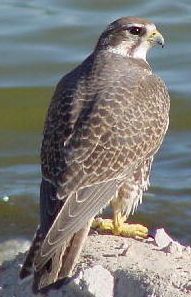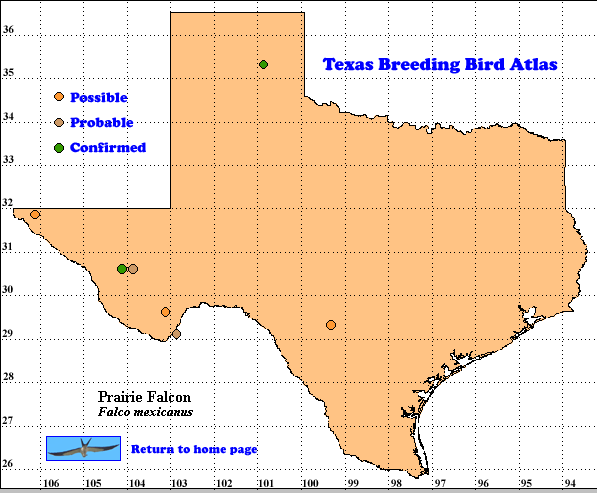Prairie Falcons, the drabbest of North American falcons, are one of at least 38 species in the world-wide genus Falco. Members of the genus are found on all continents except Antarctica, as well as islands including New Zealand, the Philippines, Indonesia and many South Pacific and Indian Ocean islands (Monroe and Sibley 1993, Am. Ornithol. Union 1998).
The habitat and prey of Prairie Falcons are quite similar to those of the much larger Golden Eagle (Aquila chrysaetos). Both species nest on cliffs with open habitat nearby where they forage for small mammals such as ground squirrels and passerine birds, especially Horned Larks (Eremophila alpestris). Finding breeding evidence for either of these raptors can be a challenging task for atlasers, but Prairie Falcons are probably the harder of the pair because of their much smaller size, much faster flight, lack of a conspicuous nest and much shorter fledgling period (Steenhof 1998, Kochert eet al. 2002). Thus Prairie Falcons may be more numerous than we realize, particularly in the most rugged and inaccessible areas of Texas, such as the Guadalupe Mountains.
DISTRIBUTION. During the 1987-1992 field work seasons of the TBBA project, observers found confirmed breeding sites for Prairie Falcons in 2 latilong-quad blocks, 35100-D7 in the Panhandle and 30104-F2 in the Davis Mountains in the Trans-Pecos, 3 probable sites in the Trans-Pecos (30104-F2, 30103-E8 and 29102-B8) and 3 possibles (31106-H1, 29103-F2 and 29099-C3). These scattered records match the assessment of Lockwood and Freeman (2004) of this species in Texas as rare and local. The single breeding record in the Texas Panhandle is similar to the situation in Oklahoma where this falcon is a sporadic breeder in Cimmaron County at the west end of that state (Jenkins 2004).
In North America Prairie Falcons breed from southern British Columbia, south Alberta and south Saskatchewan through most of the Pacific Coast and Rocky Mountain states to north Baja California and the highlands of north and central Mexico. In winter northern breeders move south and to lower elevations in areas including the western Great Plains (Howell and Webb 1995, Steenhof 1998).
SEASONAL OCCURRENCE. Prairie Falcons are present all year in Texas with migrants and winter residents augmenting the breeding population from early August to late April. Breeding records are scarce: young ready to fly were reported March 4 and a nest June 3 (Oberholser 1974). In Colorado atlasers obtained breeding evidence from April 18 to July 15 (Jones 1998), while in Arizona dates ranged from April 1 to the end of June (Moors 2005). In migration and winter these falcons are rare to uncommon in west Texas becoming casual further east (Lockwood and Freeman 2004).
BREEDING HABITAT. Little breeding habitat description for Texas is available for Prairie Falcons. A breeding record at Hueco Tanks in El Paso County (Oberholser 1974) suggests cliffs nay be important as they are across the range of this falcon (Steenhof 1998). In Colorado, 29% of breeding evidence came from cliffs. This percentage is almost the same as the percentage of confirmed breeding in this state, suggesting habitat descriptions from probable and possible records were of foraging areas. Thus short-grass prairie (39% of non-cliff habitats), pinyon-juniper (14% of non-cliff) and sagebrush (10% of non-cliff) were the most common foraging habitats. Breeding evidence in this state was most commonly found along the Front Range foothills and in rugged areas in southeast Colorado. Breeding is apparently rare to non-existent above 3000 m (10,000 ft; Jones 1998). In Arizona where cliffs were not a habitat option for atlasers, Sonoran desert habitats constituted 50% of those reported, Great Basin desert and grassland sites 21% and pinyin-juniper areas 9% (Moors 2005).
When no cliffs are available Prairie Falcons may use a dirt bank or an abandoned raven or Red-tailed Hawk (Buteo jamaicensis) nest. Usually these falcons scrape an egg cup in loose soil on a cliff ledge, in a cave, or in a crevice. The female usually lays 5 (range 2-6) white to russet eggs, often speckled with brown. The eggs are laid at 2-day intervals. Incubation lasts 29-39 days and the nestlings fledge 29-47 days after hatching and are fed by their parents for another 30-35 days (Harrison 1979, Steenhof 1998)
STATUS. Prairie Falcons are considered a rare and local resident in the Trans-Pecos (Lockwood and Freeman 2004). Since this falcon is not reported on Breeding Bird Survey routes in Texas, no trend estimate is available for this state. Data from 188 routes across the western United States and Canada suggest little or no annual population change for the period 1980-2006 (Sauer et al. 2007). Breeding locations on the map in Oberholser (1974) suggest a breeding range similar to that shown below.
Text by Robert C. Tweit (2007)
Literature cited.
American Ornithologists’ Union. 1998. Checklist of North American birds, 7th ed. Am, Ornithol. Union, Washington, DC.
Harrison, H. H. 1979. A field guide to western birds’ nests. Houghton Mifflin, Boston, MA.
Howell, S. N. G. and S. Webb. 1995. A guide to the birds of Mexico and northern Central America. Oxford University Press, New York.
Jenkins, M. A. 2004. Prairie Falcon (Falco mexicanus). In Oklahoma Breeding Bird Atlas, pp. 110-111 (D. L. Reinking, ed.). University of Oklahoma Press, Norman.
Jones, S. R. 1998. Prairie Falcon (Falco mexicanus). In Colorado Breeding Bird Atlas, pp. 130-131 (H. E. Kingery, ed.), Colorado Bird Atlas Partnership, Denver.
Kochert, M. N., K. Steenhof, C. L. McIntyre and E. H. Craig. 2002. Golden Eagle (Aquila chrysaetos). InThe Birds of North America, No. 684 (A. Poole and F. Gill, eds.). The Birds of North America, Inc., Philadelphia, PA.
Lockwood, M. W. and B. Freeman. 2004. The TOS handbook of Texas birds. Texas A&M University Press, College Station.
Monroe, B. L., Jr. and C. G. Sibley. 1993. A world checklist of birds. Yale University Press, New Haven, CT.
Moors, A. 2005. Prairie Falcon (Falco mexicanus). In Arizona Breeding Bird Atlas. pp. 158-159 (T. E. Corman and C. Wise-Gervais, eds.), University of New Mexico Press, Albuquerque.
Oberholser, H. C. 1974. The bird life of Texas, University of Texas Press, Austin.
Sauer, J. R., J. E. Hines, and J. Fallon. 2007. The North American Breeding Bird Survey, results and analysis 1966-2006. Version 7.23.2007. USGS Patuxent Wildlife Research Center, Laurel MD < http://www.mbr-pwrc.usgs.gov/bbs>
Steenhof, K. 1998. Prairie Falcon (Falco mexicanus). In The Birds of North America, No. 346 (A. Poole and F. Gill, eds.). The Birds of North America, Inc., Philadelphia, PA.

